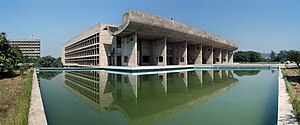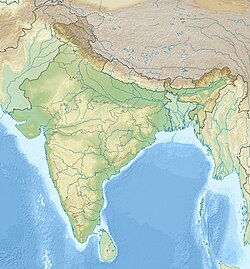Chandigarh Capitol Complex
| UNESCO World Heritage Site | |
|---|---|
 Palace of Assembly at the Capitol Complex | |
| Official name | Complexe du Capitole |
| Location | Chandigarh, Chandigarh capital region, India |
| Part of | The Architectural Work of Le Corbusier, an Outstanding Contribution to the Modern Movement |
| Includes | Palace of Assembly, Secretariat Building, Punjab and Haryana High Court, Open Hand Monument |
| Criteria | Cultural: (i), (ii), (vi) |
| Reference | 1321rev-014 |
| Inscription | 2016 (40th session) |
| Area | 66 ha (0.25 sq mi) |
| Buffer zone | 195 ha (0.75 sq mi) |
| Coordinates | 30°45′26″N 76°48′24″E / 30.7573°N 76.8066°ECoordinates: 30°45′26″N 76°48′24″E / 30.7573°N 76.8066°E |
Chandigarh Capitol Complex, located in the sector-1 of Chandigarh city in India, is a government compound designed by the architect Le Corbusier[1] and is a UNESCO World Heritage Site.[2] It is spread over an area of around 100 acres and is a prime manifestation of Chandigarh's architecture. It comprises three buildings: the Palace of Assembly or Legislative Assembly, Secretariat Building and the High Court plus four monuments (Open Hand Monument, Geometric Hill, Tower of Shadows and the Martyrs Monument) and a lake.[3][4][5][6][7] It was added to the UNESCO World Heritage Site List in 2016.
Secretariat Building
2nd International Yoga Day at Capitol Complex, 2016
See also[edit]
References[edit]
- ↑ "Le Corbusier's Capitol Complex a mess, in dire need of facelift". indianexpress.com.
- ↑ "Chandigarh's Capitol Complex is now a UNESCO heritage site". Retrieved 18 July 2016.
- ↑ "Chandigarh's Capitol Complex is now a UNESCO heritage site: All you need to know". hindustantimes.com. 18 July 2016.
- ↑ "Capitol Complex, as Le Corbusier wanted it, remains incomplete - Indian Express". indianexpress.com.
- ↑ https://indianexpress.com/article/cities/chandigarh/the-most-planned-city/
- ↑ "UNESCO approves all 3 Indian nominations for heritage tag". intoday.in.
- ↑ "Four sites inscribed on UNESCO's World Heritage List". whc.unesco.org. UNESCO World Heritage Centre. 15 July 2016. Retrieved 15 July 2016.









